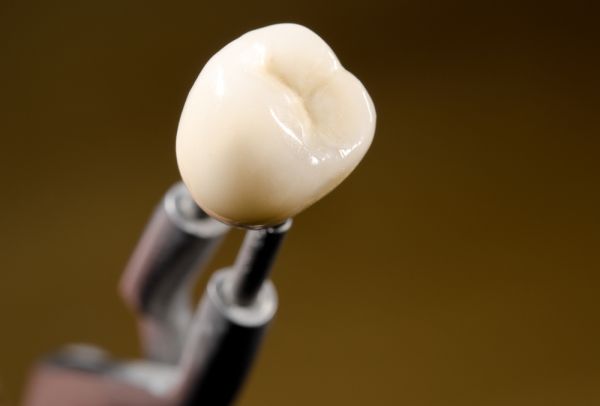How Dental Crowns Are Attached to Implants

Dental crowns atop implants are the gold standard when it comes to your tooth-replacement options. Crowns not only help to bring your bite back to its former glory in terms of functionality but also restore the appearance to give you a bright smile, as well.
What are dental implants?
Dental implants are a type of oral appliance used to replace missing teeth. Although these devices might appear as one cohesive piece, they are actually composed of three separate parts. The parts are separated so that if one fails, the whole implant will not need to be replaced. Instead, just one part can be replaced if necessary.
Implants are made up of three parts: The post, the abutment and the crown. The post is essentially a titanium screw that is surgically inserted into the jawbone, and acts as the new artificial tooth root that supports the crown and abutment. The abutment is a small peg-like support structure that connects the post with the crown. Finally, the dental crown is the actual tooth-shaped portion of the implant that fills the space where tooth loss has occurred.
It is also important to note that you will not receive your permanent implant crown on the first appointment. A healing period of about four to six months is required to wait as the bone heals around the post to allow for maximum support.
Attaching dental crowns to implants
When it is time to attach the permanent implant crown, the dentist can use two methods to place it: By using a small screw to enter the top of the crown into the abutment (known as screw-retained dental crowns), or by using dental cement to attach the crown to the abutment (known as cemented crowns).
Screw-retained dental crowns
Screw-retained dental crowns allow for retention and retrievability — meaning that they keep abutments and crowns in place effectively while still allowing ease of removal, replacement and restoration without damaging other components. Dental crowns with screws are therefore more easily maintained.
These crowns have a small hole in the top as a passageway for the screw to be placed through the artificial tooth and attach to the abutment. Because crowns do need to be replaced every once in a while, screw-retained crowns allow for easier replacement. However, due to this hole in the top of the tooth, these kinds of dental crowns are not recommended for teeth that are visible. These are best used for teeth in the back of the mouth where the hole will not be as apparent.
The screw can loosen over time, but this can be easily fixed with a trip to the dentist and a twist of the screw back into place.
Cemented dental crowns
Cemented crowns use a special type of dental cement to attach to the abutment. Although cemented crowns are more aesthetically pleasing, they are slightly more difficult to replace and maintain. Where a screw-retained crown can be easily taken apart to allow for replacement, the same cannot be said for cemented crowns. The entire crown needs to be removed when cemented crowns fail.
Many dental implant patients object to the appearance of crowns with screws. For the front and top teeth, cemented dental crowns are the clear winner.
The bottom line
A crucial part of the implant, a dental crown acts as the artificial tooth that lays above the gum line. Dental crowns are the only exposed part of the implant, and so they are more likely to need replacement over the abutment or the titanium post. However, with proper maintenance, the implant itself can last a lifetime.
Request an appointment here: https://smilesonmichigan.com or call Smiles On Michigan at (312) 509-9492 for an appointment in our Chicago office.
Check out what others are saying about our services on Yelp: Read our Yelp reviews.
Recent Posts
A smile makeover may be the answer for people who are embarrassed to show their teeth. A makeover consists of one or more dental procedures that treat or cover up imperfections with the gums or teeth. There are various methods that a dentist may use to change the appearance of one's smile, and they range…
Invisalign® is a discreet teeth-straightening method. Research shows that many people prefer this method to traditional braces. The clear aligners offer a more comfortable way to align teeth. Knowing when to choose Invisalign can help you prepare for your upcoming appointments.The metal wires and brackets of traditional braces can cause scrapes and holes in the…
Dental bonding is a reversible dental procedure that involves using a composite resin material to rebuild and restore teeth. The composites used can be matched with the color of the patient’s teeth, allowing restorations made with them to blend in.Dental bonding has cosmetic and restorative uses in dentistry. Unlike other popular restorations dentists use, its…
Wondering what a cosmetic dentist can do for your smile? Read on to learn more. A great smile can be a big self-esteem booster and a way to leave good first impressions. However, not all people have an aesthetically pleasing smile. Fortunately, a cosmetic dentist can help you improve the appearance of your teeth, gums,…